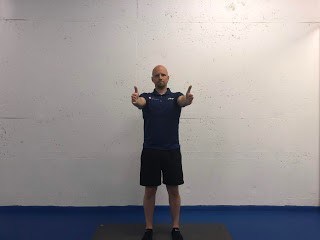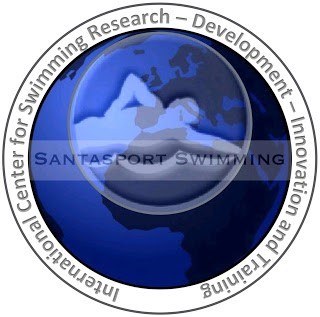Courtesy:Jakka Shemeikka
As a part of our Research, Development and Innovation functions, Olympic Training Center Rovaniemi is running a competitive swimming development program called ‘Modern Dryland Training’. It started from a simple idea of creating better solutions for dryland training for swimmers and coaches globally. Along the way, the focus has shifted to a bigger picture. Today it seems paramount, that we also raise topics that have a modern approach about the synergy of dryland and pool training.

The pelvis is one of those areas in the human body, which shows you how deep of a connection dryland training has on pool performance. It would be fair to write about the lumbo-pelvic-hip complex in total, but I really wanted to focus on the pelvis alone. Still the truth is that, it is always about entirety of the body when you perform a movement, and with that perspective, we need to take in consideration the “core”, scapula and the interrelations of these three.
If you want to dive deeper into coaching, you need to understand the individual parts of a functional line. In sports, our understanding of movement control is only starting to grow. In this path, you not only run into functional lines, but also 4 D movement. 4 D movement is something my friend, and a great movement specialist Ari-Pekka Lindberg introduced to me. 4 D movement is 3 D movement with the added dimension of timing. Timing is really important for any movement efficiency, but even more in the water where resistance is far greater than outside of it.
There is so much I could write about the pelvis connection to swimming performance, but to be able to keep this article short, let’s concentrate on a few key issues. As a swimming community, we still have a tendency to approach training mostly from a power point of view. Yes, we talk about controlling the movement and add functional movements to training programs. Despite this, most of the time our athletes fail in low level exercises, which are the starting point of any training. This puts the athlete in a position where he loses the relaxation in a performance.
The importance of pelvis control in short axis strokes
The quality that rarely comes up in discussions is pelvis control in short axis strokes, even though it is one of the determining qualities of swim speed. Lack of pelvis control exercises in our normal regimen don’t show only in the swim speed, but also in the numbers of low back pain in swimmers, as the exercises for pelvis control would also help preventing injury.
There is a real need in understanding the progressive nature of a modern training regimen. Nowadays in breaststroke, reducing drag is something swimmers and their coaches focus on when they have reached the peak force production. The way we should go about it is that the control exercises making the low drag possible would be there from the beginning of a swimmer’s career.
Below is a great example of how much difference there can be in pelvis control in breaststroke. The example is from age group swimmers, and obviously elite athletes have a smaller difference, but with added speed, even small changes can make a big difference. The same thing can also be found in butterfly performances during the pull phase of armstroke and second kick.

Example of the differences on pelvis control in breaststroke
Athletes can pick up this quality with the help of good coaching, even though it would never come up in their training. There is still too great of a chance of this happening, so it is more effective to teach it from early on. It is more difficult to teach it in the water alone, so therefore the dryland training can help a lot in this case.
Soft control of pelvis in sprint freestyle
Sprint performance is still heavily related being a power-dominated event, and long axis strokes are no exception. There is really no denying that you need a great force production in short performances, but what about the other factors? To be able to reach adequate frequency, a swimmer needs good pelvis control in relation to thorax rotation. This enables him to hold control thru out the performance.
A great way of testing your ability to control your pelvis is to do the soft control test:
- Start by standing your feet hip width apart
- Have your arms pointing forward at shoulder level

- Activate your core with exhale
- Push your left arm forward and at the same time move the right arm backwards
- Once you have reached the position in the lower picture, check if your hips remained pointing forward on both sides?
- If they are, great! If not, then practice your pelvis control
- Repeat to the other side

This really gives you an idea about the level of control in your pelvis. Pure rotational force is never enough, as you need that relaxation during the performance.
Olympic Training Center Rovaniemi is one of the six Olympic Training Center’s in Finland. Together with a diverse network of Universities, sports federations and associations, research institutes and other experts, we are able to offer a wide level of education in multiple fields of sports and well-being as well as in different sports.
Santasport Swimming is growing International development and research program for swimming. Our vision is that in the next five years we’ll run research on both learn to swim and high- performance swimming using our previous experience and soon to be built new aquatic facility. Thru our research work, we are hoping to offer new insights on swimming development.




Never has a coach told me to kick from my pelvis. So what is the difference between the hips and the pelvis?
Hi Aftershock
Thanks for the comment. It is great that people ask these questions. You are right, and I don’t tell either to kick from the pelvis, but rather kick from the hips. Term hip includes a wider area of the body, and normally with the term hip we might mean the whole hip region (from iliac crest to femur) or just the hip joint. Besides the kick, there are a lot going on in the body while you swim. Creating the base for all that movement, I feel that you have to go deeper and more simple to be able to understand and feel what it is that you are suppose to do. So that is why in this… Read more »
…and I thought core body control was important – not just the pelvis. The 2 diagrams showing br/stroke – first one is simply inefficient with so much body out of water – wouldn’t think ANYONE would teach that!
Hi Myra! You are right, it is not just about the pelvis. Then again, if you want to develop further, you have to understand the role of every part in your body. The idea in the two br related pictures was to focus on the pelvis position. Once you have figured that out, then it is far more easier to control the height.